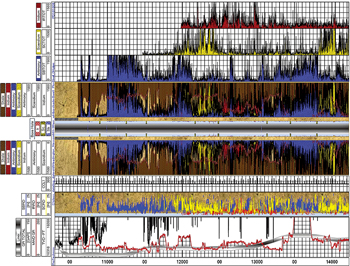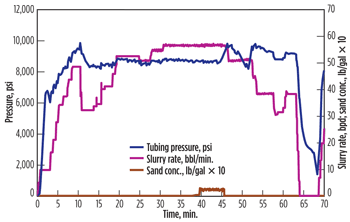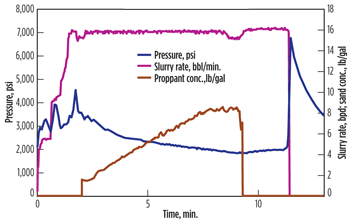ALI DANESHY, Contributing Editor, Shale
Technically, screen-out refers to a condition where continued injection of fluid inside the fracture requires pressures in excess of the safe limitations of the wellbore or wellhead equipment. Operationally, this causes a severe disruption in fracturing operations in horizontal wells and often requires cessation of pumping and cleaning of the wellbore before resumption of operations. Screen-out is an operational issue and does not necessarily mean damage to well productivity. Indeed, many wells end up being robust producers after a screen-out.
In horizontal well fracturing, screen-outs can often seriously disrupt well operations and cause cost overruns. For one thing, fracturing in horizontal wells is not a single event, but a combination of multiple successive operations that need to be performed according to a tightly orchestrated schedule and within a limited, pre-defined time span. Any disruption in one fracturing operation jeopardizes the timely completion of all the subsequent fractures and, ultimately, the start of well production.
The purpose of this column is to discuss the types of screen-outs that can occur in horizontal wells and common approaches for their prevention, or remedial steps.
Causes of screen-out. The main cause of screen-out in the vast majority of fractures is blockage to the movement of proppant inside the wellbore, perforations or fracture. (The author is not aware of any incidence of screen-out in fractures without proppant.) The details and frequency of screen-outs are largely influenced by the type of well completion, especially by whether fracturing is performed in an open hole with liner or a cemented liner.
Open hole with liner. In this case, the actual fracturing occurs in an openhole environment. The majority of screen-outs in openhole completions occur within the wellbore itself. Two factors contribute to this situation. First, the initial fracture in an open hole tends to initiate as axial (longitudinal) and then re-orient, if necessary, to become perpendicular to the least in-situ principal stress.1,2 This point is supported by many tracer surveys, which also show that the axial fracture covers the entire openhole interval, Fig. 1. Thus, the axial fracture makes it possible for fracture reorientation to occur in multiple places, so even if proppant movement is blocked within an extending fracture, the resulting pressure increase can easily cause fracture reorientation from another location within the same openhole section.
Second, as long as the openhole annulus (between the liner and open hole) is not completely filled with proppant, increased fluid pressure can cause initiation of a new fracture. Thus, in an openhole environment, the most likely location for screen-out is the openhole annulus. Figure 2 shows an example of such a case. Pressure data shows a gradual increase starting in the middle of the injection with pressure gradually building more rapidly until it causes screen-out. The very sharp pressure increase at the end of injection is the typical signature of screen-out within the wellbore. In some cases, the screen-out occurs very rapidly without any advance warning.
The operational consequences of screen-outs in openhole liner completions depend on the specific completion types. In ball-activated sliding sleeve systems, the consequences can be severe if screen-out occurs near the toe of the horizontal well. The small openings of the ball seats near the toe make it very difficult, if not impossible, to enter the well with coiled tubing or a workover string to wash the proppant out. In these cases, the initial remedy is to open the well and hope that frac fluid flowback will clean out enough of the proppant to allow the continuation of fracturing operations. If the screen-out is near the heel, it is sometimes possible to enter the well with a coiled tubing unit and wash the proppant out. Otherwise the only option may be to mill out the completion and tailor a custom completion scheme to the well condition.
 |
|
Fig. 1. Tracer survey indicating axial fracturing.
|
|
 |
|
Fig. 2. Screen-out in a horizontal open hole.
|
|
The mechanics of screen-out for open holes with liner and plug-and-perf completions are very similar to the above. However, the consequences of screen-out may not be as serious because of full bore access and the ability to enter the well with coiled tubing or a workover string and wash the proppant out.
Cemented liner. In a vast majority of these completions, multiple perforation stages are fractured simultaneously using the limited-entry technique. Depending on the detailed layout of perforations, early periods of fracture initiation and extension in these completions can be very complex. It is possible for multiple fractures to initiate from several adjacent perforations (within the same cluster) and then connect to form one or more dominant fractures that are perpendicular to the least in-situ principal stress.1 These situations can result in a very complex mix of shear and tensile fractures in the near-wellbore region. Since the proppant has to move through this complex web to get to the main fracture, it can get trapped near the wellbore and cause very high pressures and maybe screen-out. An example of this situation is presented in Fig. 3, where the excessive fracturing pressure signifies the complex web of near-wellbore fractures, the presence of tensile and shear fractures, and very poor connection between the wellbore and the main fracture. Entry of sand inside the fracture, even at a very low concentration of 0.2 lb/gal, caused an increase in pressure. Although some have suggested that this condition is symptomatic of narrow fracture width, in the author’s view, this is not a correct assessment. The more likely cause of high pressure is the poor linkage between the wellbore and the main fracture, which is created by improper completion design.
There is field evidence showing that all perforated intervals may not be fractured in a limited-entry treatment. Furthermore, there is evidence indicating that proppant distribution within the various perforation clusters may not be uniform; the farthest perforations may get more than their proportional share.3 The combination of these two situations can cause partial screen-out in the wellbore; i.e., screen-out in some but not all perforation clusters. As one perforation cluster screens out, it causes redistribution of the slurry within the remaining, smaller number of perforations, thus leading to higher perforation friction and wellbore pressure. The increase in wellbore pressure can break down one or more fractures in other perforations, reducing the friction and, thus, the wellbore pressure. This type of screen-out may actually end up helping the overall fracturing operations and well production, since it results in the creation of more fractures and more uniform distribution of proppant within the different fractures.
In cemented liner completions, the main approach to prepare the well for the remainder of the frac treatments is to clean the wellbore with coiled tubing or a workover string. Once the proppant has moved out of the wellbore, the remainder of the treatments can be completed as planned.
Dual injection systems. Most of these treatments consist of perforating the selected interval by hydrojetting using coiled tubing, and then fracturing the well by injecting the slurry either directly through the coiled tubing or through the annulus between it and the casing. One major advantage of these systems is the ability to clean the well in case of screen-out. This is done by pumping through the dead string and circulating the slurry out of the fracturing path.
 |
|
Fig. 3. High pressures caused by poor connection with the main fracture.
|
|
 |
|
Fig. 4. Screen-out at the wellbore in a dual injection system.
|
|
Screen-outs with these types of completion also often occur either at or very near the perforations. However, their main cause is different from those previously discussed. In these systems, the sand that is used as an abrasive for the perforation stage is often left in the annulus. By gravity, this sand settles to the bottom of the annulus. Due to its weight, the coiled tubing is also likely to be close to the bottom of the horizontal well. This causes the abrasive sand to accumulate and get trapped at the bottom of the horizontal annulus at high concentration. As the fracturing slurry moves through the annulus, it may not be able to fully displace the deposited sand into the perforations and fracture.
This situation becomes more severe with higher-viscosity fracturing fluids. The force of flow can slowly move the partially stagnant, highly concentrated proppant toward the perforations. When this proppant slug reaches the perforations, its high concentration causes it to become trapped at the perforations, leading to very rapid screen-out, Fig. 4. The advantage of these completion systems is that this screen-out causes only a small disruption in the fracturing operations. The proppant in the wellbore is often circulated out by injection through the coiled tubing and the fracturing operations are resumed with just a minor delay.
Conclusions. Severity and consequences of disruptions caused by screen-outs in horizontal wells depend on the type of completion. In openhole completions, the screening out of a fracture can cause initiation and extension of a new fracture from the same isolated wellbore segment without major disruption to pumping operations. However, if this results in accumulation of proppant in the annulus between the liner and the open hole, then the interruption can be severe and costly. This interruption is most severe when screen-out is near the toe of a long horizontal well with a ball-activated sliding sleeve completion.
In cemented liner completions with multiple perforation clusters, the details of well completion and perforation layout play an important role in the hydraulic connection between the wellbore and the fracture. In extreme cases, the poor connection between the wellbore and the created fracture may obstruct placement of even a small amount of proppant inside the fracture. The solution in these cases is to change the completion details and the perforation scheme. In other cases, a partial screen-out can occur in one of the created fractures without disrupting the pumping operations. In these instances the screen-out can be beneficial for well production by creating a new fracture from a different cluster and causing a more uniform distribution of the proppant in different fractures.
In dual injection systems, screen-outs are likely to be caused by the abrasive sand used to perforate the well. If this sand is not circulated out, it can concentrate and accumulate at the bottom of the horizontal annulus between the casing and the coiled tubing. If this proppant slug enters the perforations, it can block fluid movement inside the fracture, thus causing a screen-out in the wellbore. Screen-outs in these completions cause only a minor disruption in well operations. 
LITERATURE CITED
1 Daneshy, A. A., “Hydraulic fracturing of horizontal wells: Issues and insights,” SPE 140134 presented at the SPE Hydraulic Fracturing Technology Conference and Exhibition, Jan. 24–26, 2011.
2 Daneshy, A. A., “Horizontal well fracturing: Why is it so different,” Journal of Petroleum Technology, September 2009.
3 Daneshy, A. A., “Uneven distribution of proppants in perf clusters,” World Oil, April 2011.
|
THE AUTHORS
|
|
ALI DANESHY is President of Daneshy Consultants International and an adjunct professor of chemical engineering at the University of Houston, where he teaches a graduate-level course on hydraulic fracturing. Dr. Daneshy provides consulting and training services on unconventional oil and gas completions using multiple fractures in horizontal wells. He has received an SPE Distinguished Service Award for his contributions to hydraulic fracturing. / alidaneshy@daneshy.com |
|
|






